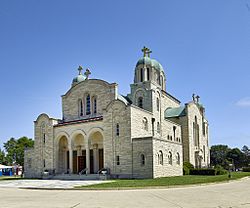St. Sava Serbian Orthodox Cathedral (Milwaukee) facts for kids
Quick facts for kids St. Sava Serbian Orthodox Cathedral |
|
|---|---|
 |
|
| 42°59′11.8″N 87°58′43.3″W / 42.986611°N 87.978694°W | |
| Location | 3201 S. 51st. Street Milwaukee, Wisconsin |
| Country | United States |
| Denomination | Serbian Orthodox Church |
| Website | www.stsava-milw.org |
| History | |
| Dedication | Saint Sava |
| Consecrated | August 26, 1956 (land); August 30th, 1958 (building) |
| Architecture | |
| Architect(s) | Camburas and Theodore |
| Style | Serbo-Byzantine architecture; Byzantine Revival |
| Completed | 1958 |
| Specifications | |
| Materials | Stone |
| Administration | |
| Diocese | Diocese of New Gracanica – Midwestern America |
The St. Sava Serbian Orthodox Cathedral (Serbian: Црква светог Саве, romanized: Crkva svetog Save) is a large and beautiful Serbian Orthodox church in Milwaukee, Wisconsin. It was finished in 1956. Inside, the cathedral is covered with amazing wall mosaics. These mosaics are so detailed that they are called "some of the most extensive and elaborate church mosaics in the United States." The cathedral is part of a larger area that also has a school and a community center. This center is called the American Serb Hall. It has been an important place for many political leaders, including some who later became President of the United States.
Contents
History of St. Sava Cathedral
Early Serbian Community in Milwaukee
Serbian people started moving to Milwaukee in the late 1800s and early 1900s. By 1912, about 2,500 Serbian immigrants lived in the city. This number grew to 6,000 by 1916. It was hard to count them exactly because some were grouped with other people from the Austro-Hungarian Empire.
On February 8, 1912, a group of Serbians decided they needed their own church. They started their first church that same year. It was located at 724 S. 3rd St. The first church service, called a divine liturgy, was held on Christmas, January 7, 1913. Between 1912 and 1942, the church had 12 different priests. They also created a group to help organize the church community. These were tough years because many men went back to Europe to fight in the Balkan Wars and World War I.
In 1942, Milan Brkich became the new priest. He was quite young but helped make the community strong again in the 1940s. Milan Brkich helped many Serbians who had lost their homes move to Milwaukee. Because of this, the Serbian population in Milwaukee grew. Their language and customs stayed strong into the 1950s.
Building the Cathedral
In the late 1940s, the church bought 14 acres of land on the southwest side of Milwaukee. The American Serb Hall was built there in 1950. It was very successful, so the church decided to build a new church building in 1951. They started a special fund, and church members were asked to give $100 each to help build the cathedral.
On August 26, 1956, they had a special ceremony to start building. Bishop Dionisije blessed the land. Soon, construction began on the cathedral, a new house for the priest, and a new school building. The construction was finished on February 4, 1958. The new cathedral was officially blessed in August of the same year.
The Cathedral and Community Today
After the cathedral was built, it hosted many important events for the church community. On August 1, 1963, Firmilian Ocokoljich was made a bishop for the Diocese of Midwestern America at this church. A year later, Milan Brkich, who had been the priest for over 20 years, retired.
Later, in the 1970s, a new cultural center was added. The American Serb Hall was also updated. A big project was completing the cathedral's beautiful mosaics. Today, the cathedral is still a very active community. In 2012, the church celebrated its 100th anniversary.
Cathedral Design and Art
The St. Sava Serbian Orthodox Cathedral was designed in the Serbo-Byzantine style. This style is inspired by old churches from the Byzantine Empire. The inside of the cathedral is almost completely covered with wall mosaics. These mosaics cost more than $3 million and took 35 years to finish.
Italian artist Sirio Tonelli designed the mosaics. They show many important Orthodox Christian figures. The art style is called Byzantine iconography. The Milwaukee Journal Sentinel newspaper said these mosaics are "some of the most extensive and elaborate church mosaics in the United States."
American Serb Hall
Next to the cathedral is the American Serb Hall. It opened and was blessed in 1950. The hall was built to honor Serbs who had died defending the United States. The hall is famous for its fish fry. This includes both dining in and a drive-through service. It is even called "America's Largest Good Friday Fish Fry." On that day each year, the hall handles about 440 fish orders every hour!
The American Serb Hall has also been a key place for many political leaders to visit during their campaigns. This includes former presidents Ronald Reagan and Bill Clinton. In January 2021, the church announced that it would sell the American Serb Hall. This was because of money problems caused by the effects of the COVID-19 pandemic.
See also
- St. Sava Orthodox School

